Even if you didn’t have the experience I had as a teenager going to summer camps where they sang the Internationale, the May Day demonstrations of 1886 and the subsequent Haymarket Riot have touched your life in ways you might not realize. The then-radical demand for an eight-hour workday gave rise to massive confrontations between activists and police, which exploded into violence on the third and fourth days of the strike. Like many romanticized events in our history, there are multiple angles of approach to understand what happened, and a wealth of material from which to build a reference library or collection.
First, a quick recap: An amalgamation of anarchists, syndicalists and trade unionists had called for a strike to commence on May 1st in Chicago in support of demands for the eight-hour day. The strike involved tens of thousands of workers and shut down much of Chicago. On May 3rd a rally was held outside the McCormick Harvest Works, where strikers amassed outside to confront a group who had undermined the strike by going to work for the machinery manufacturer despite the strike. As the closing whistle blew and the strike-breakers emerged from the plant, words became heated and scuffles broke out. Police fired into the crowd, and after the dust had cleared two unarmed strikers lay dead from police bullets. August Spies, editor of the German-language Arbeiter-Zeitung ("Workers' Times") and one of the Chicago anarchists most involved in organizing the strike, fumed: "I was very indignant. I knew from experience of the past that this butchering of people was done for the express purpose of defeating the eight-hour movement.”
In heated anger, a rally was called for May 4th to protest the police shootings. At first the rally was peaceful, but after the mayor (who was there as an observer) had left, the police advanced on the rally to try and break it up. As they moved in, an unknown person in the crowd threw a bomb at them, killing one policeman and wounding bystanders. In the chaos that followed, crossfire by police killed several more of their own ranks and an unknown number of demonstrators were injured by bullets or trampling.
.jpg)
This detail from the front page of the German edition of Frank Leslie's Illustrated Newspaper for May 22, 1886 depicts a "morning after" scene of the bombing site. (Courtesy of Beasley Books)
Eight anarchists were tried for conspiracy to commit the bombing, even though witnesses showed that none of them could have thrown the bomb itself. (Rudolph Schnaubelt, the suspected thrower, had fled the area and was never tried; many anarchists believed the bomb had actually been thrown by an agent provocateur. Paul Avrich, author of the indispensable overview The Haymarket Tragedy, concludes that there is no evidence of Schnaubelt’s involvement and argues that the main reason he got the blame was because he had fled the country). Louis Lingg, a bomb-making specialist for the anarchist movement whose apartment turned out to be full of explosives, was accused of constructing the bomb that was used on that day; in the end he escaped execution by having a blasting cap smuggled to him in prison inside a cigar. The cap blew off the bottom of his face, and as he lay dying in his cell he wrote "Hoch die anarchie!" (Hurrah for anarchy!) on the wall in his own blood.
While there is no doubt that Lingg was a builder of bombs, the use of clearly perjured testimony in the trials of his co-conspirators has led many researchers to delve into the question of how forensic evidence may have been abused in the heat of reaction to this traumatic event, during what was effectively the first Red Scare in America. On the left, those alleged conspirators who were executed in 1887 - August Spies, Albert Parsons, Adolph Fischer, and George Engel - have been immortalized as the “Haymarket Martyrs.” Two of the defendants, Michael Schwab and Samuel Fielden, whose sentences had been commuted to life in prison, were pardoned and released in 1893 by John Peter Altgeld, the governor of Illinois, who concluded after studying the evidence that their trials had been grossly unjust.
Among the expert booksellers in this field are fellow ABAA dealers Paul and Elizabeth Garon of Beasley Books, who contributed some of their research to the compendium from which many people first learn in detail about Haymarket:
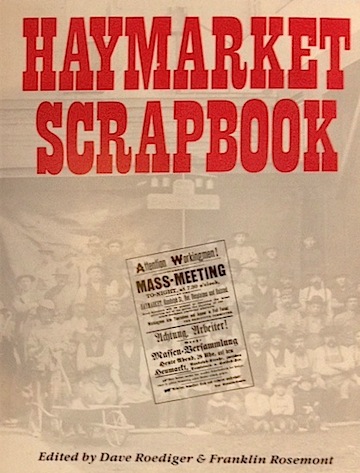
The Haymarket Scrapbook was deservedly popular and as a result is widely available on the used book market; if our $17 copy has sold by the time you read this [Edit: it has!], there doubtless will be others available on the ABAA site. For anyone thinking of collecting Haymarket material, this is a great starting point, as it uses ephemera and other publications of the time to illustrate the many turns of events.
Another must-have reference for the Haymarket collector is Robert W. Glenn’s The Haymarket Affair: an Annotated Bibliography (Westport: Greenwood Press, 1993). Beasley Books has a copy for $125 (price correct at date of first publication), which is about what one should expect to pay. [Edit: that copy has been sold.]
In 1886, as now, there was division in the anarchist movement as to whether the persuasion of ideas was sufficient to change society, or whether direct attacks against agents of the state were necessary to inspire cathartic change. The 1880s were a period of “propaganda by the deed,” when shooting politicians and poisoning priests gave anarchists an aura of serious menace that the movement lacks today. At the same time, there were critics within the movement who reviled such tactics as self-defeating adventurism. There were further divisions between thinkers who were focused on individual liberty, among whom was Benjamin Tucker of the “Boston Anarchists,” and those focused on collective liberty, and the proto-communists who were much stronger in Chicago.
The debate about whether to publicly call for armed attacks against the police made a notable impact on the leaflet that might be called the keystone item in any Haymarket collection. Captioned “Attention Workingmen!” with text in both English and German, it calls on the reader to attend the mass meeting to be held on May 4th in response to the police shooting of workers on May 3rd. It exists in two major states, the earlier version including the line "Workingmen Arm Yourselves and Appear in Full Force!"
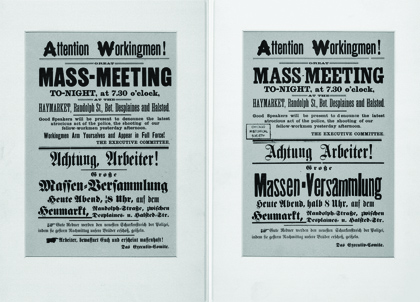
Photos of the two versions, of Attention Workingmen! leaflet (left: original version, right: revised version)
August Spies, who was scheduled to speak at the meeting, feared that it would reduce turnout by giving the impression that violence was planned. He refused to appear at the event unless that line was removed. Most of the first run of leaflets was destroyed, and a new version printed and distributed. This is by far the less rare version, though even it is extremely difficult to obtain today. A small cache sold off by the Chicago Historical Society years ago has dried up, and Bolerium’s last time handling one was way back in 1990 (it sold for $600, a figure that today inspires your humble cataloger to weep silently). An essay by the Garons, “The May Fourth Broadside,” discusses this leaflet and its states in detail, and may be found in the Haymarket Scrapbook cited above.
There are many ways to collect Haymarket material: Some seek works by activists involved in the trial, others look for ephemera reflecting conditions of the time, those with a legal bent seek documents and agitational materials related to the trial, and those on more of a budget might seek commemorative material produced by activists in later years. As with almost anything, the best material only appears on the market rarely and often disappears into a collection immediately. Here, however, are some items related to Haymarket and its legacy that can be found at this moment from ABAA dealers.
In 1887, Benjamin Tucker, who had been outspoken in his criticism of anarchist bombers in the past and argued that their methods would be destructive to the causes of both Labor and Anarchism, published an editorial by J. William Lloyd arguing that despite his previous criticisms, the execution of Haymarket martyrs on the basis of mere speech about violence deserved condemnation. “The folly of the bomb-thrower has now been overmatched by the folly of the law,” Lloyd declared on the front page of this October 22, 1887 issue of his newspaper, Liberty.

Tucker, Benjamin R. Liberty, vol. 5, no. 6. October 22, 1887, whole no. 110. New York: Benjamin R. Tucker, 1887. 8p., wraps, several closed edge tears, 10.25x14 inches. (Image courtesy of Bolerium Books)
Tucker went on to excoriate Henry George for his opposition to clemency for the accused Haymarket bombers in this pamphlet issued a decade later.
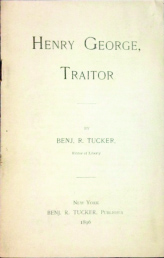
Tucker, Benjamin R. Henry George, Traitor. New York: Benj. R. Tucker, Publisher, 1896. 15p., wraps slightly soiled, very mild handling wear, 4.25x6.75 inches. (Offered by Bolerium Books)
Some collectors may wish to document the other side of the coin, with examples of invective against the anarchists.
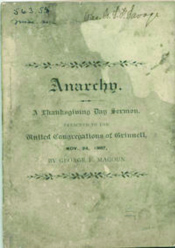
Garrett Scott, Bookseller currently offers this Thanksgiving Day Sermon, Preached to the United Congregations of Grinnell, Nov. 24, 1887 [edit: sold!] by George Magaoun (view his full listing for an interesting write-up of Magoun’s excoriation of radicals, about two weeks after the executions) [edit: link no longer available].
Many of the relatively easily obtainable Haymarket-related publications from the later 19th century are legal in nature, beginning with the speeches of the accused in court.
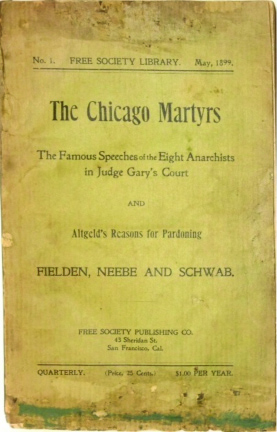
Spies, August Vincent Theodore, 1855-1887, defendant. The Chicago Martyrs. The famous speeches of the eight anarchists in Judge Gary's Court, October 7, 8, 9, 1886, and Reasons for pardoning Fielden, Neebe and Schwab by John P. Altgeld. San Francisco: Free Society, Publishers, 1899. v, 159p., wraps chipped, worn and soiled with most of the original spine gone, title page stained and worn, illus. Free Society library vol. 1, May, 1899. (Image courtesy of Bolerium Books)
John Peter Altgeld, as governor of Illinois, had pardoned the two remaining Haymarket defendants and attacked the trial as a miscarriage of justice. In addition to the statement included in the book above, his writings on this and related topics were published in a number of formats and are relatively easily collected.
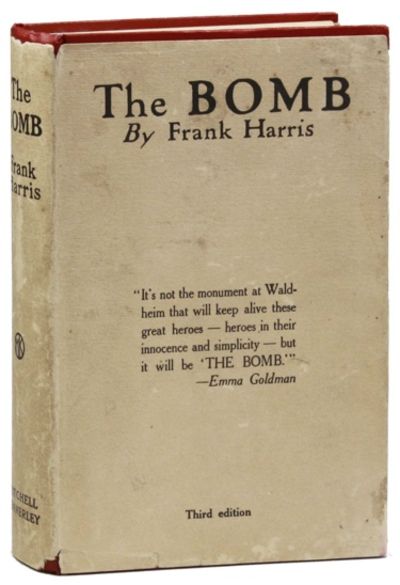
The novelist Frank Harris wrote The Bomb from the perspective of Rudolph Schnaubelt, the alleged bomb-thrower of May 4th who escaped prosecution. It is relatively common, with a number of examples available from ABAA dealers at present. This 1909 edition [edit: liink no longer available as the book has been sold] was offered by Lorne Bair Rare Books (although scarcer editions are out there for higher prices, Lorne has kindly provided a nice photo!).
In the early 20th century, as the radical left grew in complexity and new organizations emerged, activists who had no direct connection with the original events laid claim to the Haymarket legacy in varying ways. The tendency that developed the strongest public identification with May Day and Haymarket was the group that became the Communist Party, USA. There are numerous CPUSA pamphlets, leaflets and other ephemera on May Day themes, often quite inexpensive:
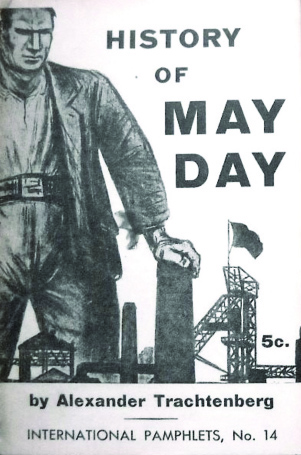
Trachtenberg, Alexander. History of May Day. International Pamphlets, New York. 1934, 31p., wraps, front wrap illustrated, illus., sixth edition. Cover illustration of this issue shows a beetlebrowed giant (labor) resting his paw on a smokestack (capitalist industry). See Seidman T91, refering to the 1930 edition. International Pamphlets no. 14. (Image courtesy of Bolerium Books)
As the Communists lay firmer claim to Haymarket and its legacy, anarchists, libertarian socialists and other anti-authoritarian groups sought to “reclaim” it from the Communist Party.
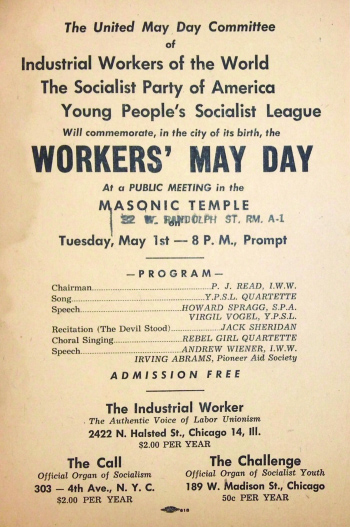
This handbill is an unusual joint production of the Industrial Workers of the World, The Socialist Party of America, and the Young People's Socialist League. One of the featured speakers was Irving Abrams of the Pioneer Aid Society, the organization founded by Lucy Parsons to support the widows and orphans of the Haymarket martyrs. (Image courtesy of Bolerium Books)
The relatively common large-format booklet illustrated below was issued by the Socialist Labor Party on the fiftieth anniversary of Haymarket. The importance of the SLP had declined considerably by this point (Jack London had once been a member, and it had played a major role in founding the IWW) but some of its publications from the 1930s have appealing cover art.
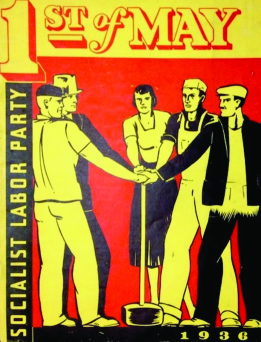
1st of May, 1936. Socialist Labor Party of America, New York. 1936, 40p., illustrated wraps slightly shelf worn, 9.25x12.25 inches, illus. Poetry by Geroge Scheftel, Varley Lang, Caesar Booth, and Joseph C. Borden, Jr. Articles by Olive M. Johnson, Arnold Petersen, Leah Epstein and Artemus Ward. (Image courtesy of Bolerium Books)
A Yiddish primer published by the International Workers Order in New York depicts students picketing to commemorate May Day.
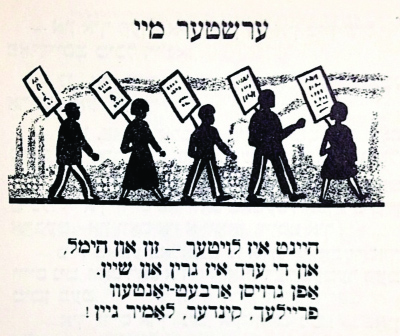
Tarant, Deborah. Mayn buch: tsvey er leyenbukh far onfanger. Cooperative Book League of the Jewish Section of the International Workers Order, New York. 1938, 80p., text in Yiddish, illustrations, very good first edition in orange boards with multicolor illustrated title label on front cover, spine ends and corners rubbed, mild overall handling wear and smudging of boards. Yiddish primer with content ranging from the typical (telling time, etc) to a section on May Day, illustrated with a vignette of children picketing with signs. (Image courtesy of Bolerium Books)
From Mexico, we find this 50th anniversary tract on the “Heroic Chicago Strike,” with a grim cover illustration depicting vast throngs of workers filing past the Haymarket martyrs after they have been hanged.
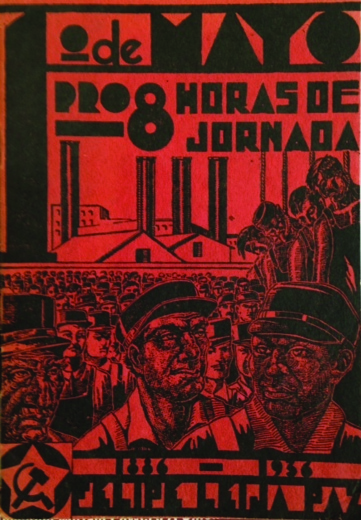
Leija Paz, Felipe. 1° de Mayo! Sintesis de los Hechos Que Precedieron a la Heroica Etapa de Chicago, en Mayo de 1886 y Que Considerase como el Exponente Mas Importante en la Implantacion de la Jornada de 8 Horas de Trabajo. Mexico: Editorial "Simiente Roja," 1936. 27 p., pictorial wraps. Small stain at lower right-hand corner. (Image courtest of Bolerium Books)
Items marking the centennial were published all over the world and could comprise a collection in themselves. Many are quite inexpensive, such as this pamphlet from France.
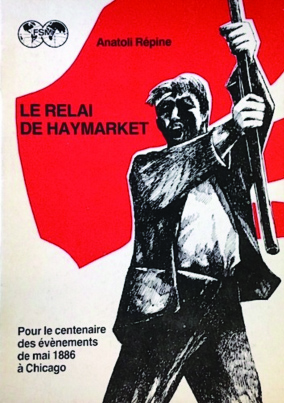
Répine, Anatoli. Le relai de Haymarket. Pour le centenaire des évènements de mai 1886 à Chicago. FSM, N.pl.. [1986], 13p., wraps. Text in French. (Image courtesy of Bolerium Books.)
Every year brings new commemorations of the great strike of 1886 and the Haymarket tragedy that followed – and new interpretations and permutations of its legacy for the reader or collector.
Search for more items related to the Haymarket tragedy here...


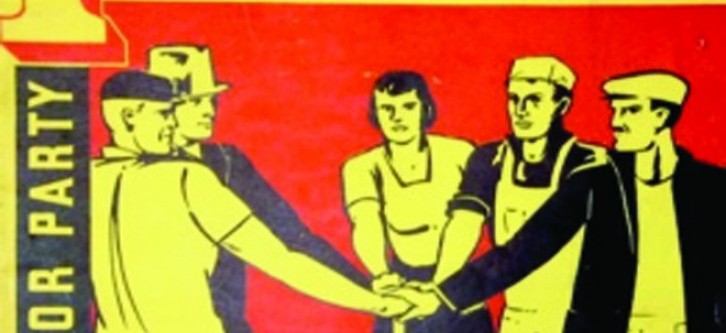
.jpg)












